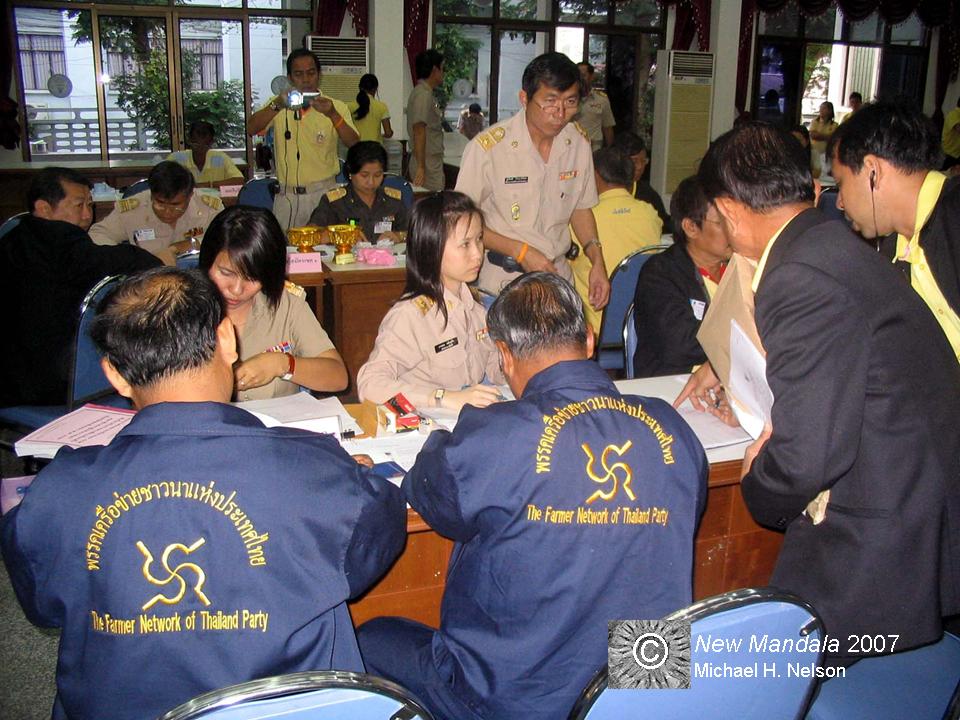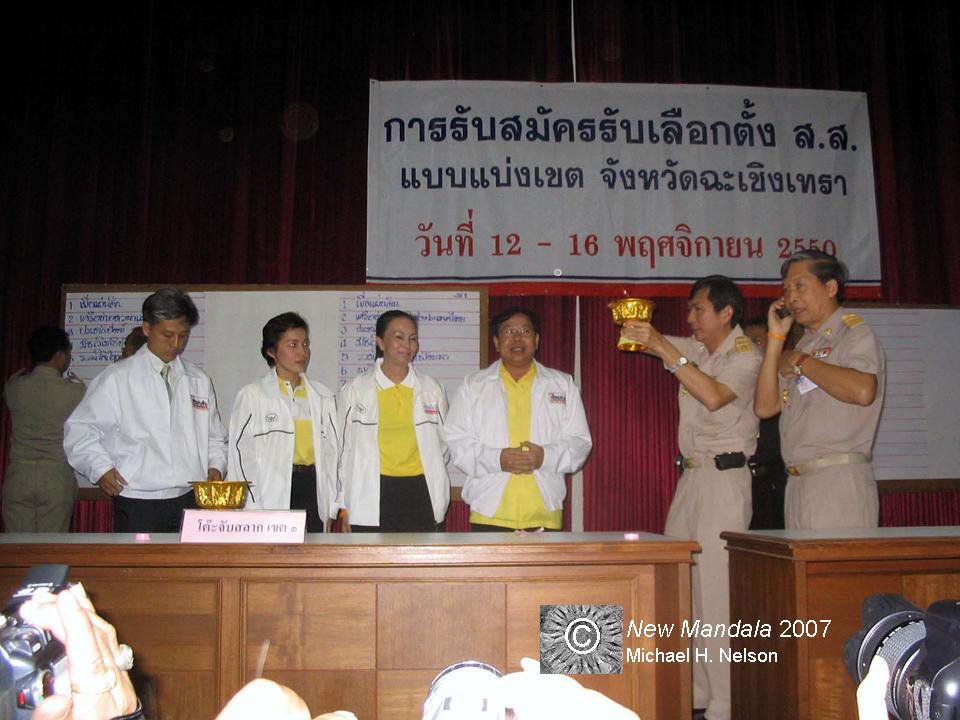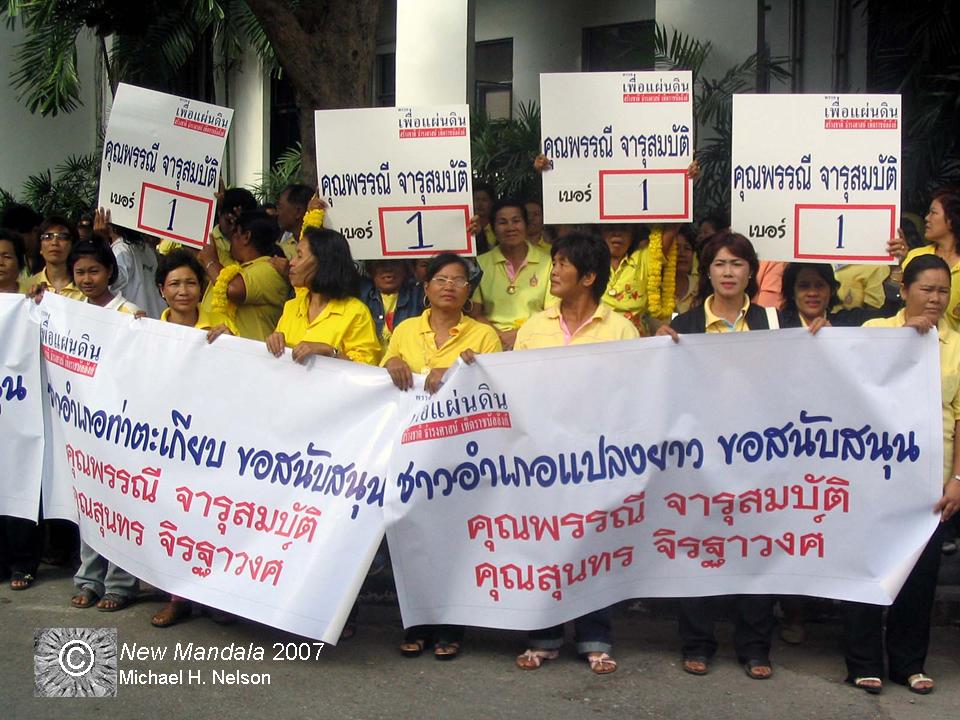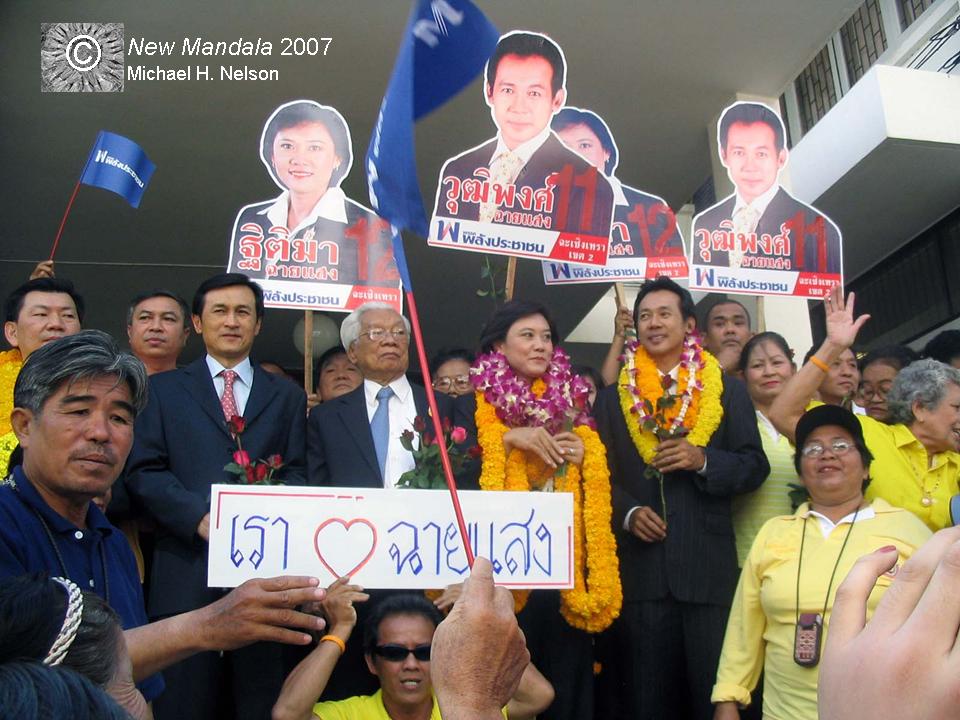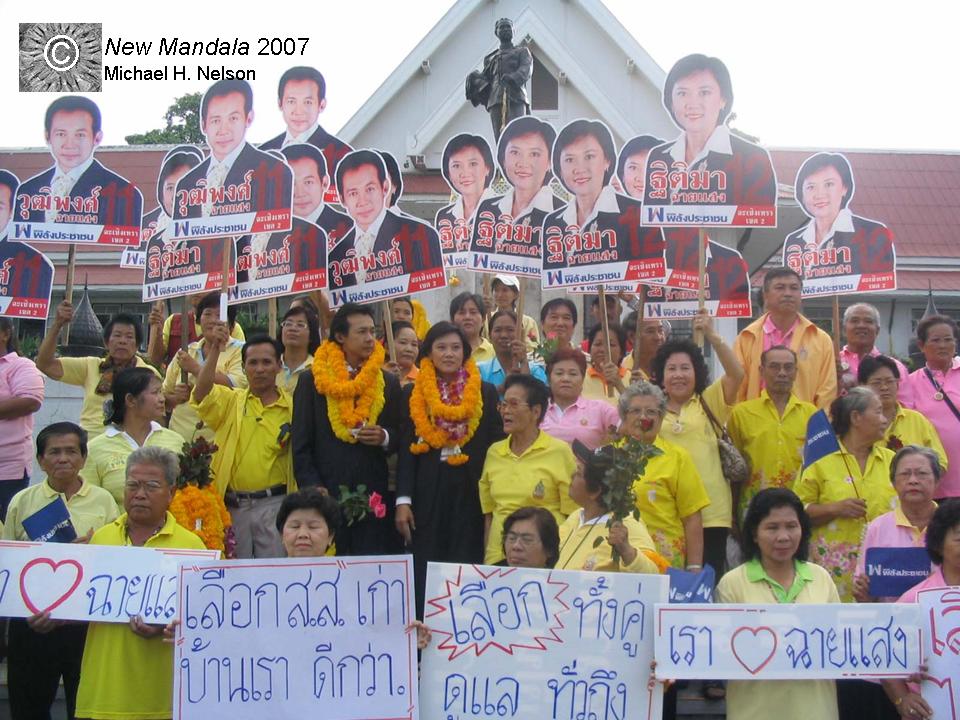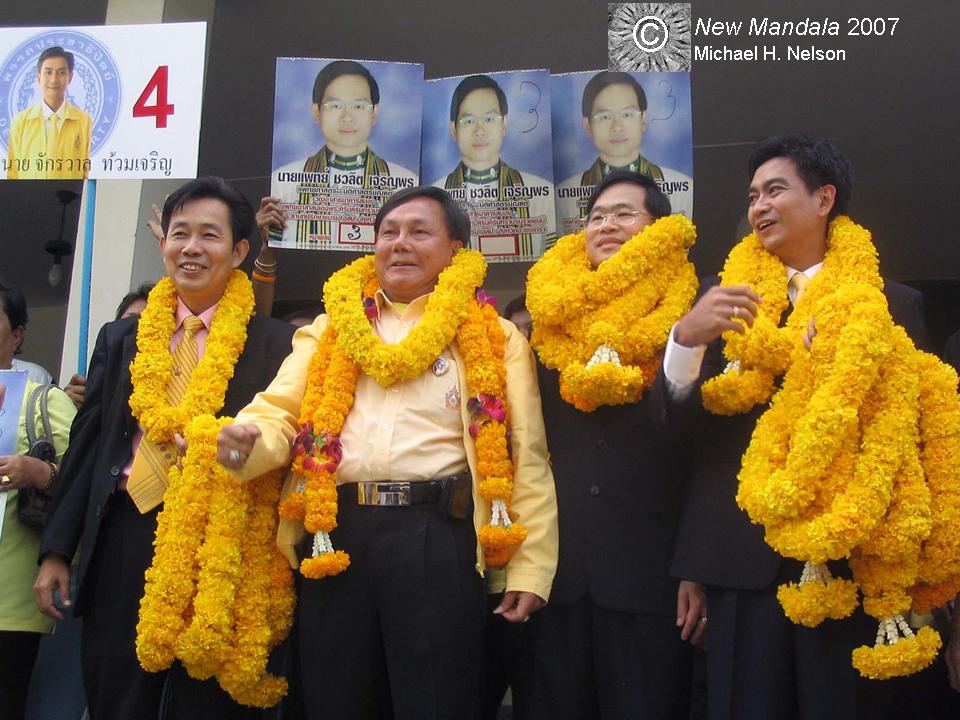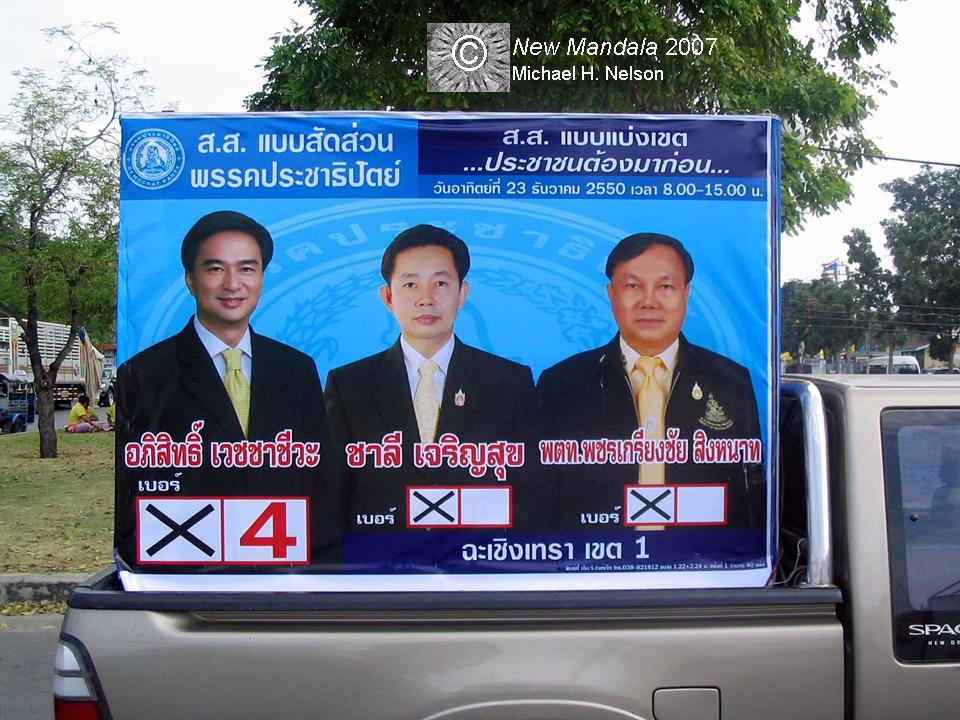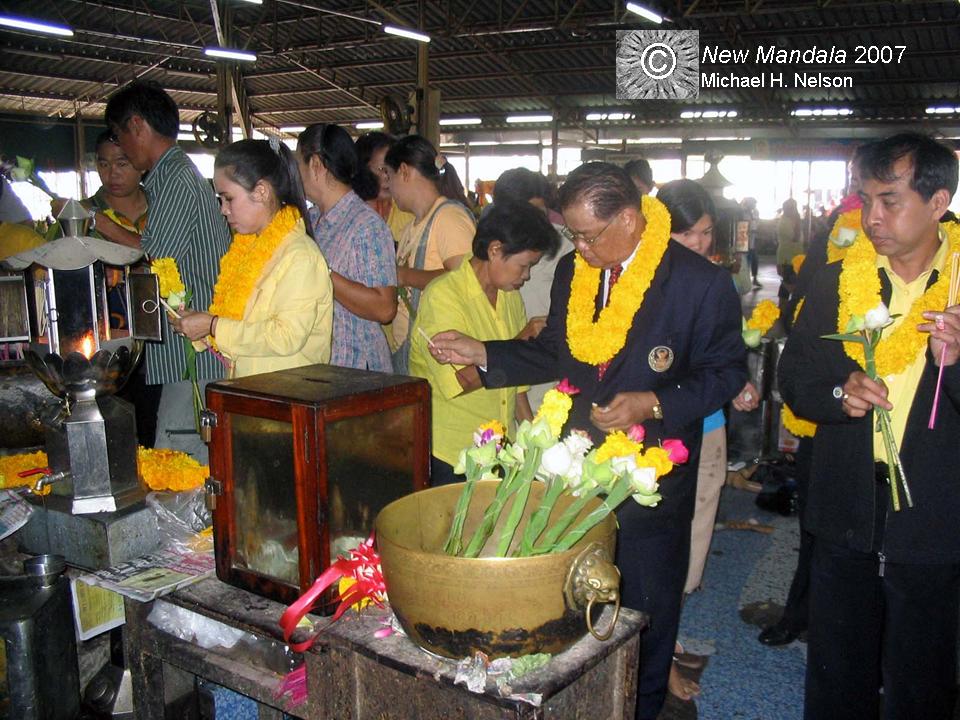Country-wide, the registration of provincial constituency candidates for the election on 23 December, 2007, takes place from November 12 to 16. After the 2007 Constitution returned from the single-member constituency system introduced by the 1997 Constitution to the previous multi-member constituency system, Chachoengsao is divided into two constituencies with two members of parliament each. The electoral administration is in the hands of the office of the provincial election commission (PEC), the two constituency committees, and district-level sub-committees. As had been the case with the constitution referendum, I have moved to Chachoengsao to observe the election as part of a project covering 14 provinces conducted by King Prajadhipok’s Institute (KPI).
When I arrived at the venue on Monday shortly after eight o’clock, registration was already underway, although it opened formally only at 8:30. Picture 1 shows officials from the office of the PEC helping members of a constituency committee with the processing of the documents of applicants from the little-known Farmers Network of Thailand Party. The man standing and wearing glasses is the director of the PEC office, Khun Chookiat. For doing their work, the officials followed a printed checklist that included items such as the application form, the confirmation letter issued by the respective political party, the candidate’s housing register, a medical certificate, ten pictures of 8.5×13.5 cm, and the payment of the application fee of 5,000 baht. The officials were also aided by a manual on candidacy registration issued by the Election Commission of Thailand (ECT). After having worked through the list, both the candidate and the director of the constituency committee had to sign it.
Picture 1
Three of the PEC’s five members, amongst them its chairperson, retired Police Colonel Krachang Rattanaphan (center), came to observe the event (Picture 2).
Picture 2
Regarding the next step, the drawing of the numbers to be allocated to the candidates, the constituency committees and the candidates sensibly agreed to use the same numbers for both constituencies (unlike, for example, in Bangkok). After lots were drawn by the director of constituency 1 in order to determine in which order the parties would draw their numbers, all four candidates of a party were invited on stage, where one member would draw the number from a gold-colored tray. Picture 3 shows the candidates of the Phuea Phaendin Party, the first to draw lots, on stage in anticipation of the drawing.
Picture 3
The candidate on the right is Phichet Tancharoen, the elder brother of Suchart, who had been MP for Chachoengsao many times, but was disqualified from running as one of the 111 members of Thai Rak Thai’s (TRT) executive board. Thus, he nominated his brother to run in his stead. TRT’s successor, the Phalang Prachachon Party (PPP), had already announced Phichet as its candidate. Subsequently, however, Suchart moved in with Phuea Phaendin, and so Phichet had to switch parties as well. On the left of Phichet is Phannee Charusombat. She is the younger sister of Phinit, an important member of TRT, who after its dissolution moved to Phuea Phaendin. Phinit used to be an MP candidate in Chachoengsao many years ago, having been born in Ban Pho district, but had moved away to another region. Until, recently, he had not played any significant political role in Chachoengsao. However, he had fielded Phanee in the Senate election of 2006, in which she came first with the truly astonishing amount of 120,586 votes, ahead of another brother of Suchart, Chaloemchai, who received merely 51,199 votes. She will face former MPs Wuthipong and Thitima Chaisaeng of PPP in constituency 2, while Phichet will have to deal with Itthi Sirilatthayakorn (a former TRT party-list MP) and Somchai Atsawachaisophon (a former TRT constituency MP) in constituency 1. While Phannee might well take away one seat from the Chaisaengs, Phichet might find his job more difficult, because his family had lost part of their traditional voter base in Thatakiap district through the PEC’s redrawing of the constituencies.
Picture 4 shows Itthi, who has a BA degree from the Faculty of Political Science of Chulalongkorn University, and Somchai giving an interview. Both were recruited into national politics via the Provincial Administrative Organization (PAO) of Chachoengsao. When Itthi moved up to TRT’s party list to be eligible for becoming a member of the government, he drew Somchai out of the PAO, on which he had served as executive chairperson and speaker of the assembly, to run in his constituency.
Picture 4
Phuea Phaendin received the numbers 1 and 2. Altogether, seven parties registered on the first day, up from two and three, respectively, in 2005. Besides Phuea Phaendin and PPP, there are candidates from the Democrat Party, Ruam Jai Thai Chart Pattana, Matchimathipattai, Farmers Network of Thailand Party, and the Chart Thai Party.
Except for Itthi and Somchai, the other major candidates had brought followers with them to cheer. Picture 5 shows some of the supporters of Phanee. The banners read, “The people of Thatakiap (Plaengyao) district support Phannee Charusombat and Sunthorn Chirathawong,” her unknown running mate. Picture 6 shows the Chaisaeng family (from left to right): Chaturon (interim TRT leader, and now disqualified), family patriarch Anand, Thitima, and Wuthipong. Note that the sign below reads “We love Chaisaeng,” without reference to a political party or a party leader. Like the other candidates, they then proceeded to pay their respect to the statue of Chulalongkorn in front of the old provincial hall (Picture 7).
Picture 5
Picture 6
Picture 7
The candidates of the Democrat Party are shown in Picture 8. They had no unified approach to their appearance on registration day, as demonstrated by the fact that only the pictures of two candidates are shown, displaying different styles. All four had already run against TRT in the 2005 elections, and all of them lost. To the left is Chalee Charoensuk, the face of the Democrat Party in Chachoengsao, and deputy chairperson of its branch. He is also a member of the provincial chamber of commerce. Next to him is a former policeman, who angered the election officials by not paying his candidate fee by five one-thousand baht notes, but by a bundle of twenty-baht notes. Next is medical doctor Chaowalit Charoenporn. He operates a clinic in Bang Pakong district. He got his first taste of electoral politics in the Senate elections of 2006, in which he came third with 29,033 votes, even beating both of the Chaisaeng’s candidates. However, his voter base will probably be much too limited to challenge Phanee or the Chaisaeng’s candidates. The Democrat’s fourth candidate is Chakrawan Thuamcharoen, a university lecturer. Running under the Ratsadorn banner, he received 18,207 votes in 2001. This increased to 30,439, when he ran for the Democrats in 2005. Still, Wuthipong comfortably beat him, receiving 52,671 votes, although the Chaisaeng camp recognized that he was a strong candidate. When I met Chalee a few weeks ago, he said on my question that Chakrawan had probably not had enough time, due, for example, to being father of a six-month old son. His wife and son turned up at the registration, and Thitima Chaisaeng talked with Chakrawan and fondly touched his son’s hand.
Picture 8
Like the Chaisaeng’s, the Democrats running in constituency 1 had already brought an advertisement vehicle with them (Picture 9). On the top left, we read, “Proportional MPs [of the] Democrat Party.” Below is the picture of party leader Abhisit Vejjajiva, with the number 4. Interestingly, Abhisit does not stand on the proportional list of the provincial cluster to which Chachoengsao belongs. The message then seems to be that people who liked the Democrats and Abhisit could always mark number 4 on the ballot paper for the proportional system, irrespective of who was running on the list in their respective clusters, because this number applied to all eight proportional clusters. This means that the national party list of the 1997 Constitution can make a reappearance, although segmented into eight clusters of provinces.
Picture 9
The final stop for the candidates was Wat Sothorn, to pay their respect to its famous Buddha statue, and ask for good fortunes in the election. The final picture (picture 10) shows candidates Inthira Rupananon and Dr. Boonlert Phairin of the Ruam Jai Thai Chart Pattana Party, before they entered the room housing the replica statue to affix gold leafs.
Picture 10
Boonlert served on the first Senate in the year 2000. Khun Inthira used to be an opposition member within the Chaisaeng’s municipal council of Chachoengsao. The ran for the provincial council in 2004 under the TRT banner, being a member of Suchart Tancharoen’s group. However, she actually is a follower of the Democrat Party, and one of her brothers ran under its label in 2001. During the election of 2005, she and a number of Suchart’s provincial councilors had helped Boonlert put pressure on the TRT candidates, via a special Senate election observation committee. When I attended one of his meetings in the provincial hall at that time, he somewhat brusquely quizzed me about what I had to do in the room. Later, he invited me for lunch, which I politely declined. When I met Khun Inthira at the market a few weeks ago, she had hopes that the Democrats would field her in constituency 2. This did not work out. She then tried Matchimathippattai, but this took too long. Only last Friday, she received the confirmation letter from Ruam Jai Thai Chart Pattana. So much for the importance of political parties in constituency elections, one might say.
 Facebook
Facebook  Twitter
Twitter  Soundcloud
Soundcloud  Youtube
Youtube  Rss
Rss 